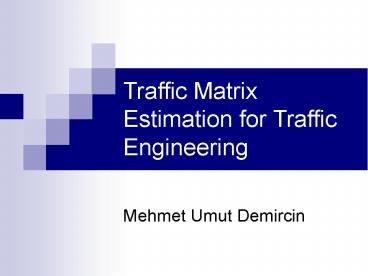Traffic Matrix Estimation for Traffic Engineering - PowerPoint PPT Presentation
Title:
Traffic Matrix Estimation for Traffic Engineering
Description:
Tomographic Estimation: Initial solution is refined by applying quadratic ... Tomography. Solution should be consistent with the link counts. ... – PowerPoint PPT presentation
Number of Views:292
Avg rating:3.0/5.0
Title: Traffic Matrix Estimation for Traffic Engineering
1
Traffic Matrix Estimation for Traffic Engineering
- Mehmet Umut Demircin
2
Traffic Engineering (TE)
- Tasks
- Load balancing
- Routing protocols configuration
- Dimensioning
- Provisioning
- Failover strategies
3
Particular TE Problem
- Optimizing routes in a backbone network in order
to avoid congestions and failures. - Minimize the max-utilization.
- MPLS (Multi-Protocol Label Switching)
- Linear programming solution to a multi-commodity
flow problem. - Traditional shortest path routing (OSPF, IS-IS)
- Compute set of link weights that minimize
congestion.
4
Traffic Matrix (TM)
- A traffic matrix provides, for every ingress
point i into the network and every egress point j
out of the network, the volume of traffic Ti,j
from i to j over a given time interval. - TE utilizes traffic matrices in diagnosis and
management of network congestion. - Traffic matrices are critical inputs to network
design, capacity planning and business planning.
5
Traffic Matrix (contd)
- Ingress and egress points can be routers or PoPs.
6
Determining the Traffic Matrix
- Direct Measurement
- TM is computed directly by collecting flow-level
measurements at ingress points. - Additional infrastructure needed at routers.
(Expensive!) - May reduce forwarding performance at routers.
- Terabytes of data per day.
- Solution Estimation
7
TM Estimation
- Available information
- Link counts from SNMP data.
- Routing information. (Weights of links)
- Additional topological information. ( Peerings,
access links) - Assumption on the distribution of demands.
8
Traffic Matrix EstimationExisting Techniques
and New DirectionsA. Madina, N. Taft, K.
Salamatian, S. Bhattacharyya, C. DiotSigcomm
2003
9
Three Existing Techniques
- Linear Programming (LP) approach.
- O. Goldschmidt - ISMA Workshop 2000
- Bayesian estimation.
- C. Tebaldi, M. West - J. of American Statistical
Association, June 1998. - Expectation Maximization (EM) approach.
- J. Cao, D. Davis, S. Vander Weil, B. Yu - J. of
American Statistical Association, 2000.
10
Terminology
- cn(n-1) origin-destination (OD) pairs.
- X Traffic matrix. (Xj data transmitted by OD
pair j) - Y(y1,y2,,yr ) vector of link counts.
- A r-by-c routing matrix (aij1, if link i
belongs to the path associated to OD pair j) - YAX
- rltltc gt Infinitely many solutions!
11
Linear Programming
- Objective
- Constraints
12
Statistical Approaches
13
Bayesian Approach
- Assumes P(Xj) follows a Poisson distribution with
mean ?j. (independently dist.) - needs to be
estimated. (a prior is needed) - Conditioning on link counts P(X,?Y)
- Uses Markov Chain Monte Carlo (MCMC) simulation
method to get posterior distributions. - Ultimate goal compute P(XY)
14
Expectation Maximization (EM)
- Assumes Xj are ind. dist. Gaussian.
- YAX implies
- Requires a prior for initialization.
- Incorporates multiple sets of link measurements.
- Uses EM algorithm to compute MLE.
15
Comparison of Methodologies
- Considers PoP-PoP traffic demands.
- Two different topologies (4-node, 14-node).
- Synthetic TMs. (constant, Poisson, Gaussian,
Uniform, Bimodal) - Comparison criteria
- Estimation errors yielded.
- Sensitivity to prior.
- Sensitivity to distribution assumptions.
16
4-node topology
17
4-node topology results
18
14-node topology
19
14-node topology results
20
Marginal Gains of Known Rows
21
New Directions
- Lessons learned
- Model assumptions do not reflect the true nature
of traffic. (multimodal behavior) - Dependence on priors
- Link count is not sufficient (Generally more data
is available to network operators.) - Proposed Solutions
- Use choice models to incorporate additional
information. - Generate a good prior solution.
22
New statement of the problem
- Xij Oi.aij
- Oi outflow from node (PoP) i.
- aij fraction Oi going to PoP j.
- Equivalent problem estimating aij .
- Solution via Discrete Choice Models (DCM).
- User choices.
- ISP choices.
23
Choice Models
- Decision makers PoPs
- Set of alternatives egress PoPs.
- Attributes of decision makers and alternatives
attractiveness (capacity, number of attached
customers, peering links). - Utility maximization with random utility models.
24
Random Utility Model
- Uij Vij eij Utility of PoP i choosing to
send packet to PoP j. - Choice problem
- Deterministic component
- Random component mlogit model used.
25
Results
- Two different models (Model 1attractiveness,
- Model 2 attractiveness repulsion )
26
Fast Accurate Computation of Large-Scale IP
Traffic Matrices from Link LoadsY. Zhang, M.
Roughan, N. Duffield, A. GreenbergSigmetrics
2003
27
Highlights
- Router to router traffic matrix is computed
instead of PoP to PoP. - Performance evaluation with real traffic
matrices. - Tomogravity method (Gravity Tomography)
28
Tomogravity
- Two step modeling.
- Gravity Model Initial solution obtained using
edge link load data and ISP routing policy. - Tomographic Estimation Initial solution is
refined by applying quadratic programming to
minimize distance to initial solution subject to
tomographic constraints (link counts).
29
Gravity Modeling
- General formula
- Simple gravity model Try to estimate the amount
of traffic between edge links.
30
Generalized Gravity Model
- Four traffic categories
- Transit
- Outbound
- Inbound
- Internal
- Peers P1, P2,
- Access links a1, a2, ...
- Peering links p1,p2,
31
Generalized Gravity Model
32
Generalized Gravity Model
33
Tomography
- Solution should be consistent with the link
counts.
34
Reducing the computational complexity
- Hundreds of backbone routers, ten thousands of
unknowns. - Observations
- Some elements of the BR to BR matrix are empty.
(Multiple BRs in each PoP, shortest paths) - Topological equivalence. (Reduce the number of
IGP simulations)
35
Quadratic Programming
- Problem Definition
- Use SVD to solve the inverse problem.
- Use Iterative Proportional Fitting (IPF) to
ensure non-negativity.
36
Evaluation of Gravity Models
37
Performance of proposed algorithm
38
Comparison
39
Robustness
- Measurement errors
- xAte
- exN(0,s)
40
Questions?































